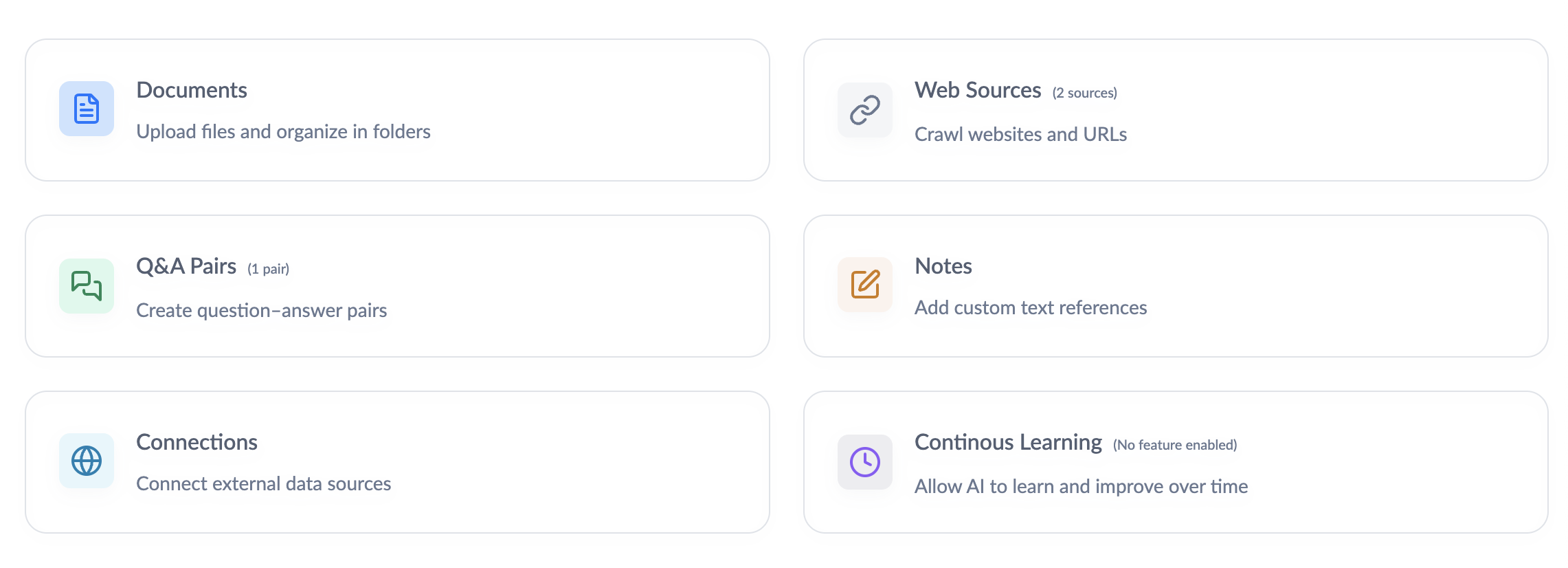Overview
Knowledge is core principle in Eloquens AI that ensures your AI-powered responses are grounded in your actual business information, rather than relying on generic AI knowledge. Think of it as giving your AI assistant access to your company's brain - all your documents, procedures, historical context, and external resources - so it can provide accurate, contextual responses that reflect your business voice and identity.
Why Knowledge Matters
Preventing AI Hallucinations
Without proper grounding, AI can "hallucinate" - creating responses that sound convincing but are factually incorrect or irrelevant to your business. Knowledge solves this by:
- Grounding responses in facts: Every response draws from your verified business information
- Providing contextual accuracy: Responses reflect your specific procedures, policies, and historical context
- Ensuring consistency: All team members get responses based on the same authoritative sources
- Building trust: Clients receive accurate information that aligns with your business operations
Real-World Benefits
- Customer inquiries get answered with your actual policies and procedures
- Internal requests reference the correct documentation and historical decisions
- Product questions use your current specifications and availability
- Support issues leverage your knowledge base and past resolutions
Knowledge Sources in Eloquens
1. Documents
Upload and organize your business documents to create a searchable knowledge base:
- Company policies and procedures
- Product manuals and specifications
- Training materials and guides
- Legal documents and contracts
- Financial reports and data sheets
How it helps: When someone asks about your return policy, the AI references your actual policy document rather than making assumptions. [learn more]
2. Web Pages
Connect external web content that's relevant to your business:
- Your company website content
- Industry resources and regulations
- Partner documentation
- Public knowledge bases
- Regulatory guidelines
How it helps: Questions about industry standards get answered with current, authoritative information from trusted sources. [learn more]
3. Q&A Knowledge Base
Build a curated collection of questions and answers specific to your business:
- Frequently asked questions
- Complex scenarios with approved responses
- Policy clarifications
- Troubleshooting guides
- Best practice examples
How it helps: Common questions get consistent, pre-approved answers every time, ensuring accuracy and compliance. [learn more]
4. Historical Email Context
Learn from your past conversations and decisions:
- Previous customer interactions
- Internal decision-making discussions
- Project communications
- Vendor correspondence
- Support ticket resolutions
How it helps: When responding to a follow-up question, the AI understands the full conversation history and previous commitments made.
5. External Application Connections
Integrate with your existing knowledge management systems:
Zendesk Knowledge Base
- Access your support articles and documentation
- Reference troubleshooting guides and solutions
- Use established support workflows and procedures
Kayako Knowledge Base
- Leverage your customer service documentation
- Access product information and help articles
- Reference support best practices and protocols
How it helps: Your AI responses stay consistent with your established customer service protocols and can reference your existing help documentation. [learn more]
6. Notes
Add specific instructions and context for each workflow:
- Special handling instructions
- Temporary policy updates
- Context-specific guidance
- Override instructions
- Custom business rules
How it helps: You can provide specific guidance for how to handle certain types of inquiries or situations unique to your business. [learn more]
How Knowledge Works for You
Intelligent Retrieval
When you receive an inquiry, Knowledge:
- Analyzes the question to understand what information is needed
- Searches your knowledge sources to find relevant, accurate information
- Combines multiple sources when needed to provide complete context
- Prioritizes recent and relevant information over outdated content
Source Transparency
You always know where information comes from citations show which documents or sources were referenced [learn more].
Getting Started with Knowledge
Step 1: Organize Your Information
- Upload key business documents to your knowledge base
- Connect relevant web resources
- Build your Q&A collection for common scenarios
Step 2: Configure Knowledge Sources
- Select which documents should be available for each workflow
- Set up connections to external systems like Zendesk or Kayako
- Add campaign-specific notes and instructions
Step 3: Test and Refine
- Monitor how Knowledge AI sources information for responses
- Review citations to ensure accuracy
- Add missing information when gaps are identified
- Update sources as your business evolves
Best Practices
Keep Information Current
- Regular updates: Review and update documents quarterly
- Remove outdated content: Archive or delete obsolete information
- Version control: Maintain clear versioning for important documents
- Change notifications: Update team when key information changes
Organize for Discovery
- Clear naming: Use descriptive filenames and titles
- Logical structure: Organize documents in intuitive folders
- Comprehensive coverage: Include all relevant business information
- Cross-reference: Link related documents and topics
Quality Control
- Verify sources: Ensure all connected information is accurate and current
- Test responses: Regularly check that Knowledge AI provides correct information
- Monitor citations: Review which sources are being used most frequently
- Gather feedback: Ask team members about response accuracy and helpfulness

Douglas Ho
Comments